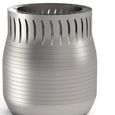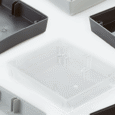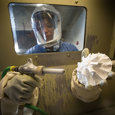You can find parts made of nylon all over the place, but what can you do if you want to use nylon but it’s just not tough enough. Glass-filled nylon is a synthetic polyamide thermoplastic and it’s one of the most important materials used in engineering thanks to its strength and heat resistance. It’s made by adding powdered glass to nylon resin or by extruding the plastic with glass fibers. For 3D printing nylon powders, glass spheres can be added to the base powder in various percentages. Adding the glass is truly a game-changer.

Advantages of Glass-Filled Nylon
Adding glass makes nylon substantially stronger, harder, and more rigid, while also having a higher creep resistance, better dimensional stability, and increased wear resistance than nylon on its own. Glass-filled nylon also allows for higher maximum service temperatures. Here are the primary benefits compared to standard, unfilled nylon:
- Considerably harder
- Superior tensile strength
- Greater stiffness
- Substantially less thermal expansion rate
- Increased stability when exposed to temperature fluctuation
- Lower creep rate
- Good fatigue strength
- High mechanical damping properties
- Ideal material for use in parts requiring high static loads in high temperatures
Disadvantages of Glass-Filled Nylon
No material is always better than another one. There are always tradeoffs. Here are some of the downsides to choosing glass-filled material:
- Substantially higher costs
- More brittle
- Quite abrasive, causing increased wear on tools
- Can erode mated parts due to increased friction
- Heavier than standard nylon
- Significantly weaker weld lines
- Anisotropic properties and shrinkage

Benefits of Using Glass-Filled Nylon for Machined Parts
Nylon is an ideal material choice for machined parts that will experience friction and wear. But when you are dealing with glass-filled nylon, the CNC machining process becomes significantly trickier and more difficult. The glass filler is highly abrasive, which can cause cutting tools and inserts to wear down rapidly. But when glass-filled nylon is handled carefully and properly, there are many benefits to using the material in your CNC machining projects. Like other nylon variants, glass-filled nylon provides good mechanical properties, fatigue resistance, noise damping, and bearing and wear resistance. Our service uses Nylon 6/6 (30% GF) Natural.

Benefits of Glass-Filled Nylon for 3D-Printed Parts
Nylon materials make strong, durable parts that have suitable properties for both functional prototyping and end-use projects. A wide array of nylons can be used for both selective laser sintering (SLS) and Multi Jet Fusion (MJF) 3D printing processes. While all printed nylons offer high levels of strength, stiffness, and temperature resistance, glass-filled nylons stand out from their standard nylon counterparts by having long term wear resistance, higher stiffness, and substantially more heat deflection resistance. We manufacture glass-filled nylon parts made from PA 12 with 40% glass-fill. One is in black, the other is PA 614-GS in white. The chart below lays out the key differences in various nylons used in 3D printing.
Comparing Glass-Filled Nylon Material Properties
|
Material |
Process |
Color |
Tensile Strength |
Tensile Modulus |
Elongation |
Heat Deflection Temp. @ 0.46 MPa |
Heat Deflection Temp. @ 1.82 MPa |
|---|---|---|---|---|---|---|---|
|
SLS |
Light Gray |
5.51 ksi (38.0MPa) |
450 ksi (3,100MPa) |
3% |
363° F |
354° F 179° C |
|
|
SLS |
White |
7.25 ksi (50.0MPa) |
522 ksi (3,600MPa) |
5% |
314° F |
204° F |
|
|
MJF |
Black |
4.35 ksi (30.0MPa) |
508 ksi (3,500MPa) |
8.5% |
347° F |
248° F 120° C |
With SLS, glass-filled nylon’s stiffness and temperature resistance makes it well-suited for components like armatures and mounting plates. With MJF, PA 12 40% glass-filled black is often used to build housings, enclosures, and fixtures. It also works well for snap fits and hinges.
Benefits of Glass-Filled Nylon for Injection-Molded Parts
All molded nylon materials possess good levels of hardness, stiffness, and rigidity. But nylon typically has poor heat resistance and fails to withstand UV light. Adding glass fibers to the nylon modifies the material, improving these properties. Nylon’s high-temperature strength improves considerably when it is reinforced with glass. Using glass-filled nylon in injection molding projects also increases a part’s wear resistance and improves its chemical resistance, except for exposure to strong acids and bases. We offer a variety of glass-filled nylon for injection molding:
- Hylon Select N1013HL (13% glass-fiber Nylon 66)
- Hylon Select N10113HL (13% GF Nylon 66)
- Hylon Select N1033HL (33% GF Nylon 66)
- Minlon 10B40 (40% Mineral Reinforced Nylon 66)
- RTP 200 203 FR (20% GF Nylon 66)
- Vydyne R533H (33% GF Nylon 66)
- Zytel HTN 51G35HSL (35% GF PPA)
- Zytel 70G13 (13% GF Nylon 66)
- Zytel 70G33 (33% GF Nylon 66)
- Zytel 73G15L (15% GF Nylon 6)
- Zytel 77G33L (33% GF Nylon 6/12)
- Zytel 80G14AHS (14% GF Nylon 66)
- Zytel 8018 HS (14% GF Nylon 66)
Glass-filled nylon is electrically nonconductive, making it useful as a shield for electrical and automotive applications. Here are some additional benefits of using glass-filled nylon in your injection molding projects:
- Increased rigidity
- Improved hardness
- Superior tensile strength
- Increased creep resistance
- Greater dimensional stability
- High mechanical damping
Nylon—and more significantly glass-filled nylon—can be more susceptible to warp due to non-linear shrink, so choosing the ideal type of nylon to suit your specific needs is crucial. If your part will be in a humid environment, bear in mind that nylon is a hygroscopic material that will absorb moisture, which may cause dimensional and structural issues. Also, glass-fill sometimes has dimensional pitfalls when working with semi-crystalline materials. Thus, it can be a bit of a trade-off.









